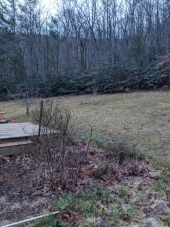


Roberto pokachinni wrote:Depending on your tree's water needs, either plant it in a (circular) hole above the ditch or below it. Depending on how dry the slope becomes, you can tie the hole to the ditch with a small connector channel to feed the hole water.

Roberto pokachinni wrote:Hi Tyler...

Judielaine Bush wrote:I'm on the north slope of clay hill, too. Our house caught sheets of run off during heavy rain events. We cleared the overgrowth behind our house and did have the opportunity for some heavier equipment, so we put in swale/hugels: the largest trunks of some of big sweetgums were laid out almost on contour (but with a clear drainage to away from the house) and dirt from the uphill side was scooped and dumped on the logs. We had many many logs and no need to burn them. Using the logs as sponges and the swales to redirect has made a huge difference, especially during some historically wet seasons. Getting something to check and redirect runoff might help you.

Eric Hanson wrote:Tyler,
I was actually thinking about some type of swale, even if just a short one.
Eric

Sebastian Köln wrote:Alder could work. It grows fast and loves water and clay.
We have an alder forest here on varying slopes from 0 to 100%. The forest floor is generally good to walk on unless it is a very steep slope or animals or humans have exposed the clay below it…

Eric Hanson wrote:Tyler,
Welcome to Permies!
Tough challenges! I can think of two things that you could possibly do to help. The first, as already mentioned, is to get some good, deep rooting cover crops growing. This will help to improve/build soil and will help with the mud.
Secondly, is it possible that you could divert some of the water that flows across the land? Even if you could adjust drainage a little bit, you might be able to save yourself some goopy, sloppy conditions.
Eric
